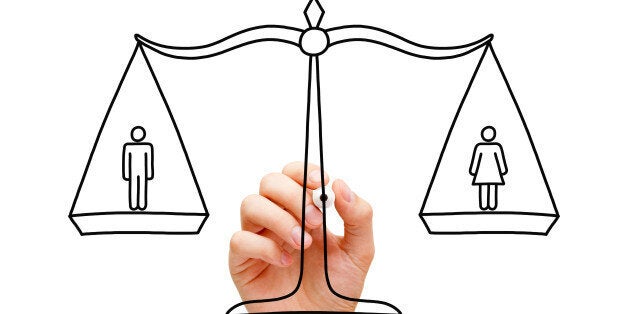
Last week, I was both honoured and humbled at being named one of the Champions of Women in Business by the FT and HERoes.
I have always been passionate about diversity in the workplace. Diversity is now undeniably proven to be good for business (recent McKinsey research found that with 30%+ female leadership, companies can expect to add up to 6% to its net margin), as well as very simply just the right thing to do. Although I appreciate the recognition, I'm acutely aware that our journey is still in its infancy and we have a long way to go until the companies in which we work truly reflect the customers we serve and the societies in which we live.
Can men take the lead on gender equality?
To some, I could easily look like part of the problem on gender equality. After all, I'm a man in a leadership position. But I've always believed that progress can be accelerated with the support of vocal allies, and that men like myself can have a positive role to play in the journey towards gender equality.
The more we understand about the root causes of inequality, the clearer it becomes that we need active support and participation from every leader. The fact that I'm a man doesn't mean there should be any less expectation for me to actively champion diversity and gender equality to the best of my ability.
A neverending journey
Three years ago, we set a goal of 50/50 gender balance within LinkedIn's EMEA Marketing Solutions business, the area for which I'm responsible.
Our experience has shown us that with with a focused effort and agreed success metrics in place, you can make considerable progress. But although we have already made excellent headway, we still have a long way to go until there's true gender parity across our broader leadership teams and the business as a whole.
I wanted to take this opportunity to share some of the lessons that we have learnt on our journey, many of which surprised us. We also uncovered issues that ran far deeper than we suspected when we started out. Identifying and addressing even the most uncomfortable of these issues is the only way to achieve true gender equality. And this requires active involvement from everyone, male and female alike; your organisation cannot afford passengers where diversity is concerned:
Lesson Number 1: Uncover unconscious bias
One of the most uncomfortable lessons was that everyone suffers from unconscious bias, even men and women who are the most passionate supporters of diversity. It's one of the reasons why putting women into positions to make senior appointments doesn't automatically mean that more women are appointed into those senior roles.
We brought in specialist, external providers who could help bring these influences on our decision-making to the surface. The external perspective was hugely helpful - because it's very difficult to analyse yourselves as an organisation in this regard. I can't recommend training like this enough - but one session alone won't do it. This bias is so deeply ingrained in every person's psyche that it can take months and years to identify the ways it could be influencing decisions.
Lesson Number 2: Review a candidate slate only when it's 50/50
It's been easy for those who want to ignore the gender equality issue to argue that there's a simple reason for fewer women being in leadership roles: because they're not interested in them - and therefore don't put themselves forward. That was the argument recently made by one senior advertising executive that led to his resignation last year. It's wrong. Unconscious bias and the signals sent to women about their suitability distort the playing field long before the interview process begins.
The best way to tackle this is to insist on seeing a good mix of diverse candidates before you bring someone into a role. If that means you have to work hard to surface suitable female candidates, then that's what you have to do. Manage expectations by signalling that this could take more time - because choosing from the first line-up of people you see is likely to be a distortion.
Lesson Number 3: Insist on a diverse interview panel
One of the most disappointing discoveries we made was an instance of a female candidate meeting six white men during their interview process. This not only removed diverse perspectives from the interview feedback but also sent a terrible message to the candidate. Demonstrating that people are coming to work for a diverse team, which puts decision-making equally in the hands of men and women, makes a difference. It can help to remove some of the barriers that prevent women applying for, and taking on different roles.
Lesson Number 4: Create sponsors not just mentors
Many companies have developed great acceleration programs for future female leaders, which include matching them with senior mentors within the business. These initiatives work well and should be applauded. However, mentors will only take you so far; you also need sponsors.
What's the difference? Mentors talk with you; sponsors talk about you. It's part of their responsibility to increase your visibility internally and externally, reference your strengths in conversations with key influencers and importantly, and advocate for you when there are stretch assignments and new career opportunities available. The underlying challenge is that men promote themselves and their capabilities more frequently than women; in a recent study, we found that women include 11% fewer skills on their LinkedIn profiles than men.
Lesson Number 5: Check your language
It's amazing how much male bias is embedded within the internal and external-facing content that businesses create. Automatically referring to C-suite decision-makers as 'he' is a case in point. It's not just bad grammar - it can have an outsized impact on your employees' perceptions of how equal a business you really are.
Lesson Number 6: Be patient, transparent, consistent and resilient
Gender equality won't happen overnight. It took three years to achieve it for our LinkedIn Marketing Solutions business and we are still on a journey more widely across LinkedIn. There are steps that you can take to accelerate the process - but you have to be careful to avoid shortcuts. Guard against complacency, and be aware of resistance from both men and women; as one group fears their opportunities becoming limited, the other is concerned about being promoted due to gender rather than ability. Making decisions on merit is the only true way to embed gender equality - and that requires patience.
Lesson Number 7: Without a foundation of belonging, diversity will fail
Belonging is the magical combination of security, significance, impact and fun - all of which are essential foundations for a diverse culture. Belonging breeds confidence and open-mindedness, and helps to unlock many of the defensive barriers (conscious and unconscious) that can stand in your way. It's also essential to maintaining and building on gender equality once it's achieved. It's one thing to hire diverse people into a range of different roles - another to ensure they are happy, fulfilled and able to perform at their best once they are in role. Plus there's a big difference between a workplace with different types of people in it, and a working culture that actively champions diversity.
The journey continues
Our journey towards gender equality at LinkedIn has had some successes - but that doesn't mean that the journey is over. The lessons we've learned on our way to gender parity demonstrate exactly why this needs to be a continuous process. Otherwise, it's far too easy to slip back and let those unconscious biases re-emerge.
I appreciate we are not alone in realising how far there is to go. LinkedIn data shows that the percentage of women hired into Chief Marketing Officer roles was 35% higher in 2016 than it was in 2008, and the number of women hired into leadership roles in Technology has grown 18%. However, this still means that only a third of the CMOs hired in 2016 were women and only 5% of those filling tech technology leadership roles.
We're not yet at the tipping point where the number of women in leadership roles is sufficient to topple the unconscious biases and unwitting distortions that stand in the way of gender equality. We won't get to that tipping point unless we take concerted, committed and proactive action to achieve it. Our journey shows that gender balance in the workplace is possible. However, it also shows how far we all have to go to ensure that it happens.
